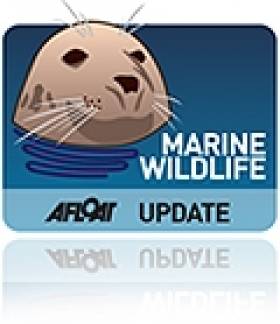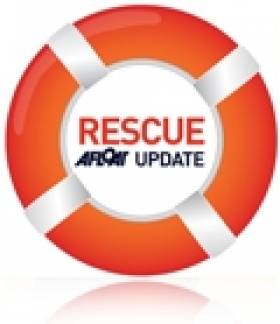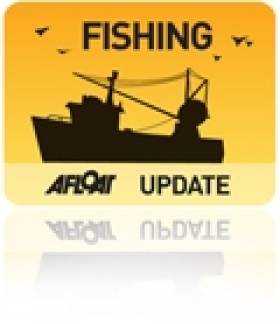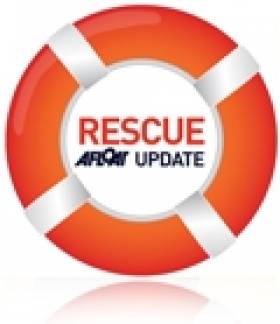Displaying items by tag: fishermen
Fears Over Illegal Cull as Seals, Dolphin Die on Waterford Beach
#MARINE WILDLIFE - Fears are growing of an illegal cull of marine wildlife after a seal and dolphin were discovered dead on a Waterford beach - just hours after two seals were found dying from bullet wounds in the same location.
TheJournal.ie reports that the wounds on the two animals found on Tramore Beach on Thursday are also believed to be from gunshot.
Two grey seals were euthanised the previous evening after they were discovered gravely injured with "horrific" wounds on the same beach.
A spokesperson for the Irish Seal Sanctuacy (ISS) has called for a post-mortem of the animals to determine the exact cause of death - but pointed the finger at an illegal cull allegedly carried out by local fishermen.
"We’re not against a properly regulated cull," said the ISS's Johnny Woodlock, "but it’s the guy who goes out with a shotgun and takes potshots, that’s what we’re against.”
TheJournal.ie has more on the story HERE, including an image that many may find distressing.
Search for Glandore Fishermen to be Wound Down
#NEWS UPDATE - The search for two fishermen still missing after their boat went down off West Cork nearly three weeks ago will be wound down next week, The Irish Times reports.
Search teams have been combing the area for any trace of Michael Hayes (35), skipper of the Tit Bonhomme, and crewman Said Mohammed (23) after the fishing vessel ran aground in rough seas near Adam's Rock, at the mouth of Glandore Harbour, on Sunday 15 January.
The bodies of Kevin Kershaw (21), Attia Shaban (26) and Wael Mohammed (35) were recovered in the days and weeks following the tragedy. Only one of the six-person crew - 43-year-old Abdul Mohammed – is confirmed to have survived.
As previously reported on Afloat.ie, last weekend saw more than 90 divers embark on an extensive search of the wreck site and the Glandore bay area, with hundreds more volunteers searching the coastline and on land.
Coastguard 'Overwhelmed' By Response to Glandore Search Appeal
#NEWS UPDATE - The Irish Coast Guard told RTÉ News that it has received an "overwhelming" response from the diving community to its appeal to join the search in West Cork for two missing fishermen.
Skipper Michael Hayes and crewman Saied Ali Eldin are still missing after the fishing vessel Tit Bonhomme ran aground in rough seas near Adam's Rock at the mouth of Glandore Harbour.
Only one of the six-person crew - 43-year-old Abdul Mohammed – is confirmed to have survived. The bodies of Kevin Kershaw (21) and Attia Shaban (26) were recovered last week, while the remains of Wael Mohammed (35) were found by civilian divers near the wreck site last Sunday.
Coastguard manager Declan Geoghegan said that search teams now have the 48 divers required to conduct an exhaustive search of the wreck area and urged further volunteers not to travel for the moment.
The search will concentrate on the waters between Adam's Rock and Long Point, where much of the debris from the trawler has washed up.
RTÉ News reports that more than 200 volunteers are assisting the coastal search by boat and on land, which is being co-ordinated from the village of Union Hall.
Search Continues for Three Fishermen Still Missing in West Cork
#NEWS UPDATE - The search is set to resume again this morning for the three fishermen not yet recovered after their trawler sank off West Cork last Sunday.
Skipper Michael Hayes and Egyptian crewmen Saied Ali Eldin and Wael Mohammed have been missing since the fishing vessel Tit Bonhomme ran aground and went down in rough seas near Adam's Rock, at the mouth of Glandore Harbour.
Only one of the six-person crew, 43-year-old Abdul Mohammed, is confirmed alive after he was able to reach the shore immediately following the incident.
As previously reported on Afloat.ie, Garda divers retrieved the body of Attia Shaban (26) on Thursday morning, followed in the afternoon by that of Kevin Kershaw (21).
Yesterday the search was expanded to cover an 18-mile radius after a dive at the wreck site was unsuccessful, according to The Irish Times.
Divers from the Garda and Naval Service will continue to focus on the wreck today, helped by favourable weather conditions, while volunteers join in the wider search of the coastline.
It emerged on Friday that that boat's aluminium wheelhouse sheared off in the rough seas that followed for three days after it ran aground.
RTÉ News has video of the search operation in progress HERE.
Fatality Rate for Fishermen An 'Absolute Tragedy'
Fishermen and farmers make up more than half of all work-related fatalities in Ireland, according to the Minister for the Marine.
As The Irish Times reports, Simon Coveney TD decried it as an "absolute tragedy" in the Dáil.
He noted the progress being made in encouraging people to wear safety gear when on the water, but said there was "little or no progress in getting fishermen to wear lifejackets”.
"For some reason fishermen seem to think they will never fall in the water," the minister commented.
Cork South West TD Noel Harrington also raised the point of the Department of the Marine's refusal to use personal beacons that directly signal emergency services, rather than emergency position indicating radio beacons (EPIRB).
He referred to the capsizing of the Rambler 100 yacht in the Fastnet Race in August, saying that the latter did not go off to alert the coastguard as the boat had not sunk.
Two Fishermen Rescued After an Hour in the Water
Liverpool Coastguard received a 999 call from a member of the public at just after 1.30pm. The caller had heard calls for help from the water and spotted two people in difficulty off Silloth, Cumbria. Coastguard Rescue Teams from Maryport and Burgh by Sand were sent to the scene with the RNLI Inshore Lifeboat from Silloth and Maryport Inshore Rescue Boat.
The fishermen were rescued from the water by the RNLI Inshore Lifeboat and taken to hospital in Carlisle by ambulance. It then transpired that they had been fishing for shrimps at Cardurnock Flats, four miles from where they were found. It appears that their net got caught and their ten-metre fishing vessel 'Boy Bailey' turned over in the water. The vessel then sank and the men spent an hour drifting in the water, supported by life rings.
Tony Topping Liverpool Coastguard Watch Manager said:
"These fishermen were extremely lucky. Firstly they managed to grab life rings and then the tide carried them the four miles down to Silloth.
"The MCA recommends that commercial fishermen wear a personal floatation device or lifeline whilst working on the deck of a vessel at sea. This will keep you afloat should the unexpected happen and if you also have your vessel fitted with VHF DSC radio equipment which can send a distress alert you'll also have a way of calling for assistance when you need it."
Lost Irish Fishermen Found Safe and Sound Off Minehead
FOUR Irish fishermen reported missing on Sunday have been found in good spirits off the coast of Minehead in Somerset.
This Is The West Country reports that the four men had left Helvick harbour in Co Waterford early on Sunday on a fishing trip but got lost shortly thereafter.
After contacting the coastguard with their concerns, the Helvick Head RNLI lifeboat was dispatched to Minehead, where the lost boat had been found by another fishing vessel, Faoilean Ban.
The lost fishermen subseqently followed the Faoilean Ban back to port at Helvick.
Those participating are asked to assemble at the Hibernia Inn (near Bray Dart Station) from 13.00 hours. At 14.00 hours, an anchor shaped wreath will lead the procession of wreaths to the north Bray pier-head where a memorial service will be held, at which representatives of those in attendance will be invited to speak.
This will be followed by one minute's silence after which, those accompanying the wreaths will embark on the flotilla to a position approximately five-cables due east of Bray Harbour.
Anyone who would like to assist in the preparations and to remember those who have been lost are invited to attend. For further information, contact Tony O'Grady, Captain, (retired) on behalf of "Mariners with Memories" on Tel: (01) 276 0575 Mob: 087 245 4071 Email: [email protected] in addition to this LINK.
Visiting Castletownbere this weekend, the Minister for Agriculture, Food and the Marine, Simon Coveney TD, announced a 'Special Assistance for Young Fishermen' scheme. Fishermen under 40 years of age who have not previously owned a fishing vessel can avail of grant aid up to 15% (to a maximum of €50,000) of the acquisition cost of a second-hand whitefish vessel.
Speaking about the scheme the Minister called it, "a positive stepping stone for future entrepreneurship within the fishing industry". He also highlighted how "new blood and fresh thinking are essential for the ongoing development of any industry. This Scheme will assist and enable young fishermen who have a proven track record within the sector to set themselves up as managers of their own vessels, set their own targets and goals, and hopefully impart their knowledge to those they take on to work with them."
The Minister also announced €84,000 in grant aid for seven seafood companies in the Cork area under the BIM Seafood Value Adding Scheme. The grant aid underpins an overall investment of €213,500 in the area.
As he announced the grant aid, the Minister congratulated the companies on their successful projects, "Focusing on innovating and adding value will secure a long term, competitive future for Irish seafood companies. It is heartening to witness the level of ingenuity and creativity coming from these companies, backed by a sound business capacity. It really bodes well for the seafood industry's future in Cork".
The Minister has also requested that BIM would begin a comprehensive economic survey of the Castletownbere area to determine the level of seafood activity in the area and establish its economic importance for the region. Minister Coveney said "This Report will provide hard economic evidence on the dependence and economic importance of seafood in the region. This will help to inform future policy making for the area at Local, National and EU level. With the completion of world class harbour facilities in Castletownbere in the coming months it is vitally important that everybody can work together to maximise the true economic potential of the Region. I feel this study by BIM, highlighting the economic importance of the Seafood sector for the Region, will help to drive on the development of the industry in West Cork and Castletownbere in particular".
Adding value to Irish seafood is a key strategic driver for BIM as Ireland's seafood development agency and they estimate that an additional €50 million in value added seafood sales can be created by 2012. The opening of BIM's Seafood Development Centre in 2009 has encouraged significant uplift in new product development and innovation, with 178 seafood companies availing of its services in 2010. For more information on the Seafood Value Adding Scheme visit www.bim.ie
Rescue Alert Over Trawler Mayday in Irish Sea
The News & Star reports that RNLI Workington responded to the fishermen's mayday call along with Maryport's coastguard and inshore rescue team.
Engline failure is being blamed for the incident, which occurred before 9.30am on Monday morning. The trawler has since been towed to Ireland for repairs.





































































